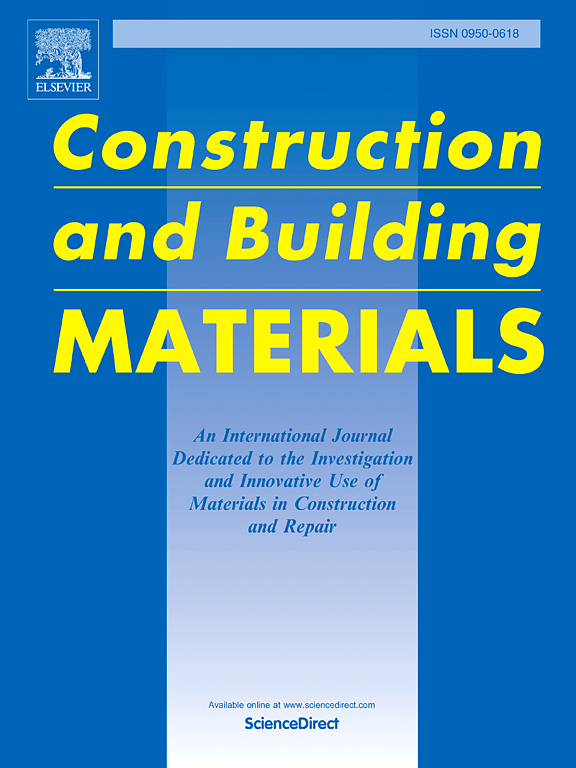不同养护制度下高延性胶凝复合材料的性能演化:水化动力学、微观结构发展和力学行为
IF 8
1区 工程技术
Q1 CONSTRUCTION & BUILDING TECHNOLOGY
引用次数: 0
摘要
高延性胶凝复合材料(HDCC)具有优异的应变硬化性能和多重开裂能力,在工程应用中具有很高的应用前景。但在标准养护条件下,掺合物含量过高导致早期强度发展缓慢。蒸汽固化有效加速水化和火山灰反应,增强机械性能,细化微观结构,提高生产效率。尽管有这些优点,但由于缺乏标准化的蒸汽固化制度,导致性能结果不一致。本研究通过从微观水化过程到宏观力学性能的多尺度方法,系统研究了HDCC在蒸汽养护和标准养护条件下的性能演变。结果表明:(1)提高蒸汽养护温度,缩短水化成核和生长阶段,延长扩散控制阶段,加速水化动力学;快速溶解FA释放Al3 +,破坏AFt的稳定,促进其向AFm的转化。过高的温度进一步诱导AFt分解、SO42-解吸和DEF形成,导致微观结构损伤和长期耐久性降低。(2)蒸汽固化对纤维-基体界面性能影响显著。高温暴露会增加界面摩擦,减少化学结合,从而削弱纤维桥接,从而影响拉伸延展性和多重开裂行为。(3) 60℃养护5天的强度和延性可与60 - 90天的标准养护相媲美,在满足工程要求的同时大大缩短了施工工期。该研究加深了我们对不同固化条件下HDCC性能演变机制的理解,为材料设计提供了坚实的理论基础。此外,它还为优化HDCC蒸汽养护制度、平衡性能和时间效率以及促进工程应用的广泛采用提供了科学指导。本文章由计算机程序翻译,如有差异,请以英文原文为准。
Performance evolution of high ductility cementitious composites under different curing regimes: Hydration kinetics, microstructure development, and mechanical behavior
High ductility cementitious composites (HDCC) exhibit exceptional strain-hardening behavior and multiple cracking capabilities, making them highly promising for engineering applications. However, the high mineral admixture content leads to slow early-age strength development under standard curing. Steam curing effectively accelerates hydration and pozzolanic reactions, enhancing mechanical properties, refining microstructure, and increasing production efficiency. Despite these advantages, the absence of standardized steam curing regimes results in inconsistent performance outcomes. This study systematically examined the performance evolution of HDCC under steam curing and standard curing conditions through a multi-scale approach, encompassing microscopic hydration processes to macroscopic mechanical properties. The findings revealed that: (1) Increasing steam curing temperature accelerates hydration kinetics by shortening the nucleation and growth phase while prolonging the diffusion-controlled stage. Rapid FA dissolution releases Al3 + , destabilizing AFt and promoting its transformation into AFm. Excessive temperatures further induce AFt decomposition, SO42- desorption, and DEF formation, resulting in microstructural damage and compromised long-term durability. (2) Steam curing significantly influences fiber-matrix interfacial properties. High-temperature exposure weakens fiber bridging by increasing interfacial friction and reducing chemical bonding, thereby compromising tensile ductility and multiple-cracking behavior. (3) A curing regime of 60 °C for 5 days achieves comparable strength and ductility to 60–90 days of standard curing, meeting engineering demands while considerably shortening construction timelines. This research deepens our understanding of the mechanisms underlying HDCC performance evolution under different curing conditions, providing a robust theoretical foundation for material design. Furthermore, it offers scientific guidance for optimizing HDCC steam curing regimes, balancing performance and time efficiency, and fostering broader adoption in engineering applications.
求助全文
通过发布文献求助,成功后即可免费获取论文全文。
去求助
来源期刊

Construction and Building Materials
工程技术-材料科学:综合
CiteScore
13.80
自引率
21.60%
发文量
3632
审稿时长
82 days
期刊介绍:
Construction and Building Materials offers an international platform for sharing innovative and original research and development in the realm of construction and building materials, along with their practical applications in new projects and repair practices. The journal publishes a diverse array of pioneering research and application papers, detailing laboratory investigations and, to a limited extent, numerical analyses or reports on full-scale projects. Multi-part papers are discouraged.
Additionally, Construction and Building Materials features comprehensive case studies and insightful review articles that contribute to new insights in the field. Our focus is on papers related to construction materials, excluding those on structural engineering, geotechnics, and unbound highway layers. Covered materials and technologies encompass cement, concrete reinforcement, bricks and mortars, additives, corrosion technology, ceramics, timber, steel, polymers, glass fibers, recycled materials, bamboo, rammed earth, non-conventional building materials, bituminous materials, and applications in railway materials.
 求助内容:
求助内容: 应助结果提醒方式:
应助结果提醒方式:


